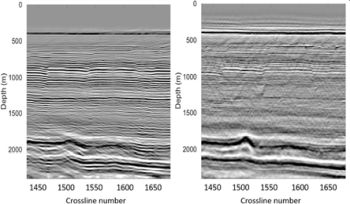Prøveforelesning - tid og sted
Fredag 17 januar, 9:15-10:00, Auditorium 1, Geologibygningen:
Gas hydrates – Images and Characterization
Kreeringssammendrag
Seismiske avbildningsmetoder er mye brukt i petroleumsindustrien i forbindelse med leting etter hydrokarboner, feltutvikling, og overvåkning av reservoarer. Kjente utfordringer i forbindelse med disse metodene er lav oppløsning og et dårlig signal-til-støyforhold (SNR) ved avbildning av komplekse geologiske regioner slik som i Barentshavet. Dette ph.d.-arbeidet har hatt som fokus å forbedre seismisk avbildning av en kompleks undergrunn basert på følgende tre hovedbidrag: (1) en rask og effektiv måte for støyreduksjon representert ved tensorimplementering av Common-Reflection-Stack (CRS) metoden, (2) forbedret prestack dybdemigrasjon for 3D komplekse modeller med anisotropi og (3) tomografisk hastighetsanalyse basert på bølgefelts-attributter.
Hovedfunn
Populærvitenskapelig artikkel om Zhaos avhandling:
Improvements in seismic imaging and migration-velocity model
Seismic imaging methods have been widely used in the petroleum industry for hydrocarbon exploration and reservoir monitoring. The principle of seismic imaging methods is employing elastic waves generated by seismic source to obtain images of the subsurface.

In seismic acquistion, the emitted seismic waves propagate down into the Earth, and are reflected and refracted at each lithostratigraphic boundary. Those reflected waves are recorded by sensors near the surface within a defined time period, and are subsequently processed in order to image the subsurface structures, predict the types of rocks encountered and determine the presence of hydrocarbons (oil and gas).
With the progress of exploration and production, the petroleum industry has moved into exploring fields that have ever more complex geological structures, such as the salt deposits in the Nordkapp Basin in the Norwegian Barents Sea and pre-salt discoveries in the Santos Basin in Brazil. The conventional seismic processing and imaging methods have challenges with the quality of resolution, signal-to-noise ratio (SNR) or accuracy of the image in such geological scenarios.
This thesis focuses on the development of improved high-resolution seismic imaging techniques, in combination with the iterative, 3D velocity model-building approach, in order to address velocity modelling and depth imaging in complex geological scenarios. As a result of this work, three main contributions have been made to improved seismic imaging:
- (1) A fast and robust seismic wavefront, or Common-Reflection-Surface (CRS), attributes estimation method in CRS stacking to provide improved SNR in seismic images of complex subsurface geological structures.
- (2) An improved Fourier mixed-domain prestack depth migration technique to image vertical transversely-isotropic (VTI) media with large lateral contrasts and complex structures.
- (3) A new time-migration velocity estimation algorithm using nonlinear mapping of seismic wavefront attributes based on the kinematic time migration and demigration schemes.
Foto og annen informasjon:
Pressefoto: Hao Zhao, portrett (500px). Foto: Gunn K Tjoflot | Seismic image from the Barents Sea: (left) Image derived from proposed Fourier-mixed-domain depth migration algorithm, (right) Image derived from the conventional common-angle depth migration. Bilde: Hao Zhao (440px).
